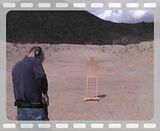I posted this before and some said there wasn't enough explanation on the video. Allow me to lay out the details in writing, then you may have a better understanding of the drill and when you are ready, incorporate it into your regimen.
Although it may just look like a fancy fast shootin' demonstration, it is actually a valuable training drill.
One of the most important skills to develop is to be able to "call" your shots.
This means to know where your shot hits by seeing where the sight is.
Another is to track your sight and let what you see trigger the shot, not what you think.
When you can call your shots and know you are tracking the sight, the
"Bill Drill" (named after Bill Wilson of Wilson Combat) is a good tool for refining your sight and trigger skills.
Here's how it is done:
One target at 7 yards. Start with the gun in the holster, hands at sides. Draw and fire 6 shots in under 2 seconds. It only counts if you shoot 6 "A's".
You should know how well you have done just from watching the sight.
How to "build" in to it:
Watch the Double Tap and Transition videos so you understand tracking the sight and prepping the trigger.
First run:
Fire one shot at the target, release the trigger, track the sight and prep the trigger. When the gun is back on target, stop. Don't fire the second shot. Call your shot without looking at the target.
Start again.
Run 2:
Fire one shot at the target, release the trigger, track the sight and prep the trigger. When the gun is back on target, fire the second shot. Track the sight, release the trigger, prep the trigger. When the sight is back on target, stop. Don't fire the third shot. Call your shots without looking at the target.
Start again.
Repeat the process until you have reached 6 shots.
Remember, tracking the sight, releasing the trigger and prepping the trigger should all occur before the gun settles back on target. Ideally, you should be able to call all of your shots. Shoot as fast as you can shoot all "A's". When you start dropping a lot of points, focus more on the sight and trigger (never think in terms of slow down or speed up).
If you don't have a holster, start from low ready.

 |

























Bookmarks